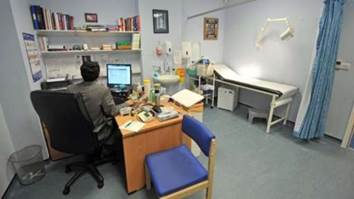A GP’s Office: Reception and Exam Room
Hello, I’m James Barton. I’m a GP and work in a medical practice. Our practice serves the medical needs of the surrounding residential area.
As you enter the practice, you put on shoe covers and go to the reception. Our two receptionists are responsible for initial patient contact. They make appointments and take messages from patients and other health care providers.

Next to the reception, there is a spacious waiting and child play area with soft armchairs and sofas and lots of magazines on the tables and toys in the boxes and on the shelves. There is a water dispenser in the corner and a flat-screen TV on the wall.


For disabled patients, there is a wheelchair ramp to more easily access the building. There are some wheelchairs and two special toilets in the waiting area.


Our practice employs four GPs, so we have got four examination rooms. All of them look the same, and have got the same furniture and equipment. First of all, there is a modern examination table (couch) with a disposable cover to reduce the risk of infection.

There is a weighing scale, a height measure, a blood pressure monitor, a stethoscope, an otoscope (auriscope) with disposable tips, an ophthalmoscope, an eye chart, a reflex hammer, an electrocardiograph. To take a closer look at the throat or the ears of a patient, I use an examination lamp and sometimes a torch. We have a defibrillator for emergency situations.
Next to the examination table there is a trolley with all necessary supplies (tongue depressors, thermometers, cotton pads, cotton buds, forceps, syringes, etc.) and a medicine cabinet.


There is a sink with hand soap and tissues in the corner. Before any examination or procedure, I wash my hands with soap and rub them with a sanitizer. After that, I put on a mask and examination gloves. As you can guess, they are disposable, too. If we use reusable devices and tools, we clean and disinfect them regularly. If any items are out of stock, the nurse tells the manager.
All the surfaces in the examination room are washable. That’s why there are not any curtains on the windows and rugs on the floor.
2.2. Выпишите из упражнений и текстов английские эквиваленты следующих слов и выражений. Выучите их.
1) Район; 2) бахилы; 3) приемная; 4) кулер; 5) инвалид, пациент с ограниченными возможностями; 6) пандус; 7) инвалидная коляска; 8) смотровая; 9) кушетка; 10) ростомер; 11) весы; 12) стетоскоп; 13) отоскоп; 14) одноразовые наконечники; 15) офтальмоскоп; 16) таблица для проверки зрения; 17) электрокардиограф; 18) неврологический молоточек; 19) смотровой светильник; 20) дефибриллятор; 21) шпатель; 22) термометр; 23) ватные диски (тампоны); 24) пинцет; 25) шприц; 26) дезинфицирующее средство; 27) смотровые перчатки; 28) многоразовый.
2.3. Выпишите из текста слова частей речи и выражения, которые подходят под следующие категории:
1) equipment in the GP’s practice;
2) necessary supplies;
3) maintaining hygiene and infection control in the GP’s practice.
2.4. Вставьте в предложения необходимые по смыслу слова из текста A GP’s Office: R eception and E xam R oom, обозначающие предметы медицинского оборудования. Выпишите и выучите слова и выражения, обозначающие действия персонала и пациентов при использовании медицинских приборов (например, измерить вес и т.д.).
1) The nurse uses a __________________ to measure weight or calculate mass.
2) The nurse uses a ____________________ to measure the height of a patient.
3) To take a patient’s blood pressure, the nurse uses a ___________and a ________.
4) To look into a patient’s ears (e.g. to see a foreign body in the ear canal), the doctor uses a device called a _____________.
5) To measure a patient’s visual activity and screen a patient for vision problems, the doctor uses an __________.
6) To test deep tendon reflexes, practitioners use a ______________.
7) To detect and diagnose heart abnormalities, doctors use an __________.
8) A device which delivers a dose of electric current to the heart in life-threatening situations is called a _____.
9) To examine the mouth and throat of a patient, the doctor may use a ____ and a ____.
10) To take your temperature, you can use an ear, underarm or oral ______________.
11) To stop or prevent bleeding from minor punctures such as injections, the nurse can us____________.
12) To clean the ear canal and remove earwax, many people use ________, though doctors do not recommend this method.
13) To extract teeth, dentists use ______.
14) To give injections and vaccinations, nurses most often use ______.
3. GRAMMAR PRACTICE. Конструкция «There is/are». Предлоги места.
3.1. Рассмотрите изображение кабинета врача и заполните пропуски необходимыми пространственными предлогами и выражениями.
| Across from behind on (2) in the left-hand corner to the right of next to under over between |

Look at Dr. Barley’s office. He uses it as an examination room.
There is a large desk with a PC (1) __________ it. As you know, Dr. Barley has a lot of paperwork to do. (2) ___________ the desk there is a patient’s chair. (3) ____________ the desk there is a waste paper basket. (4) __________, one can see a printer.
(5) __________ the desk, there is an examination couch with a disposable cover. (6) __________ the couch, one can see a stool and a box (or it may be a fridge). (7) __________ the couch there is a trolley with all necessary supplies. Actually, the trolley is (8) __________ the couch and the sink. (9) __________ the couch, there is an examination lamp.
There are some shelves (10) __________ the wall with a lot of books and medical guides.
3.2. Составьте вопросы к тексту 1.1. “ A GP ’ s Office : Reception and Exam room ” по образцу. Употребите правильные предлоги и артикли. Дайте краткие и развернутые ответы .








